|
44. Satyrium ilicis (Esper, 1779) / Ilex hairstreak / Lycaenidae – Theclinae
NL: bruine eikenpage / D: Eichen-Zipfelfalter, Brauner Eichen-Zipfelfalter / F: thécla de l’yeuse
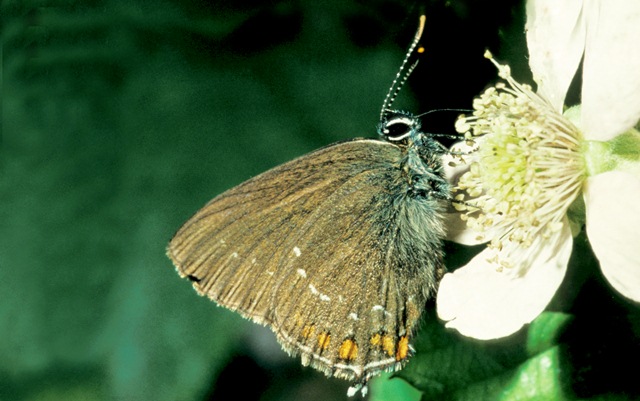 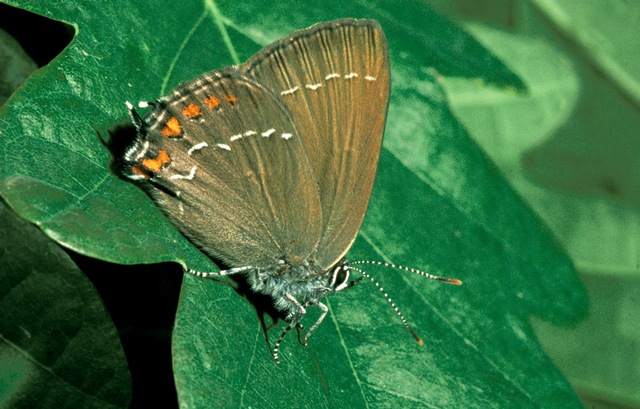 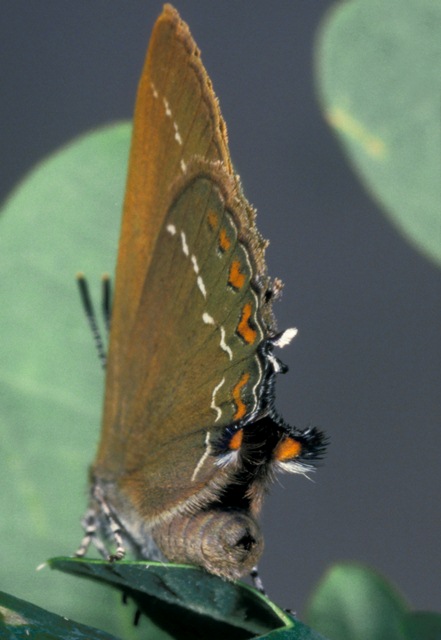
Photographs: Frits Bink ©.
Small, wing length 16 (15-17) mm. In the Benelux, the species is known from all countries where it inhabits woodland; in the Netherlands it is found also in the dunes, although scarce and local. It is found in scrub wood of young oaks, in particular in the margins of woodland to heathland, on rides and open areas in woodland.
Butterfly is on the wing from mid-June until mid-August and peaks end-July and occurs in maritime to continental climates, amplitude 6 to 16. Required heat sum 750°d, maximal tolerated 2000°d, corresponding climate windows 24 and 38 weeks.
The species resembles Favonius quercus: however, this is a specialist feeding particularly on the male flowers of the oak, whereas Satyrium ilicis feeds on the buds, young shoots and leaves. The former is a species of woods with tall trees, the latter of brushwood and shrubs.
Ecological characteristics
Behaviour over time
Overwintering: egg on twig of the host-plant.
Reproduction: oviposition starts after 5-6 days when the body contains 26 (24-28) eggs, estimated potential reproduction 2.5 times as much.
Larval feeding periods: 5 weeks in the period mid-April until early-June.
Generations: always one.
Spreading of risk: not observed.
Life cycle: egg 39-43 weeks; larva 30 (28-34) days; pupa 19 (14-23) days.
Life span of adult: rather long, 3 weeks.
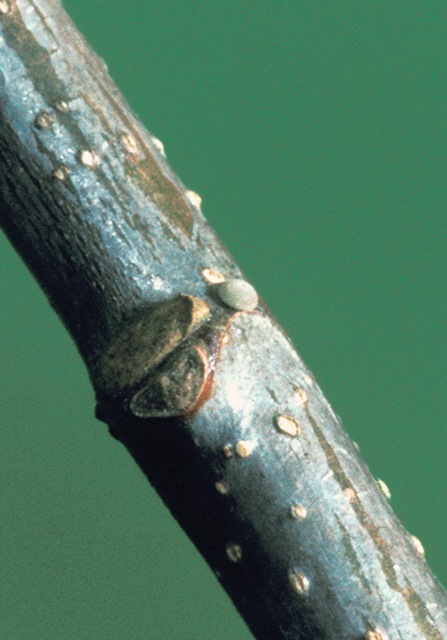 
Photographs: Frits Bink ©.
Behaviour in space
From stay-at-home to migrant: stay-at-home, spatial requirement modest.
Finding a mate: males perch but sometimes also congregate on a flowering bush, females look for the male and possess a conspicuous speculum.
Orientation in the landscape: gradient between wood and open field, also gaps in the canopy.
Oviposition: on a second year twig near a notch or bud.
Defence
Threats from other organisms: no special defence from avian predators.
Myrmecophily: larvae are rarely attended by ants in the temperate climate zone, the pupae can stridulate.
Threats from the environment: its occurrence is restricted to a wood.
Feeding habits
Adult: honeydew and nectar of flowers such as brambles and alder buckthorn.
Larva: hatches before budburst and feeds on the bud as soon fresh tissue becomes available, after sprouting it will sometimes bore into the new stem to feed on the marrow and after leaves develop it eats the petiole making the leaf wither prior to eating it. The larva pupated in the litter layer.
Larval foodplants
Plant species: Fagaceae, Quercus cerris, Q. petraea, Q. pubescens, Q. robur.
Journal
Rearing experiments based on specimens from Maashorst, Netherlands:
17 July 1985: females captured from bramble and alder buckthorn.
21 July: first eggs are laid on one and two year old twigs. Freshly laid eggs are purple-brown in colour. At 30°C the butterflies are fully active, at 43°C they look for shade.
Up to 28°C the butterflies bask.
Eggs overwintered outside and two rearing experiments were carried out:
Experiment 1: Eggs brought indoors.
20 April 1986: first egg hatched.
26 April: larva had bored into bud of oak, which had begun to sprout.
29 April: larva had bored into 2 buds.
30 April: in moult L1/2.
4 May: moulted to L3, green in colour and ate leaves.
9 May: in moult L3/4.
13 May: larva had bitten through midrib of older leaf.
14 May: larva prepared to pupate under a stone.
18 May: pupated with girdle.
1 June: first adult emerged.
Experiment2: Eggs remained outside:
30 April 1986: no eggs had hatched.
3 May: 5 eggs had hatched.
6 May: all eggs had hatched.
20 May: larvae were preparing to pupate.
4 June: first adult emerged.
9 June: 5 males and 1 female had emerged.
10 June: copulation observed.
12 June: last pupa hatched.
Table 44-1. Results of dissections

Table 44-2. Collection and observation localities
F, Brittany, Forêt de Chevré, 47° 39’ 11”N – 3° 01’ 37”W; 1 August 1981.
F, Lorraine, Rupt devant Saint-Mihiel 280 m, 48° 53’ 01”N – 5° 24’ 10”E; 28 June 2006.
NL, Maashorst 51° 43’ 33”N – 5° 35’ 33”E; 17 July 1985.
NL, Schuitwater 51° 28’ 35”N – 6° 07’ 43”E; 18 June 2000.
Fig. 44-1. Satyirum ilicis, phenogram adapted from Fichefet et al. 2008: 149.
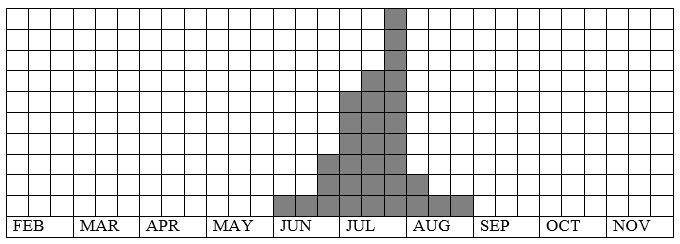
Fig. 44-2. Satyirum ilicis, habitat characteristics.
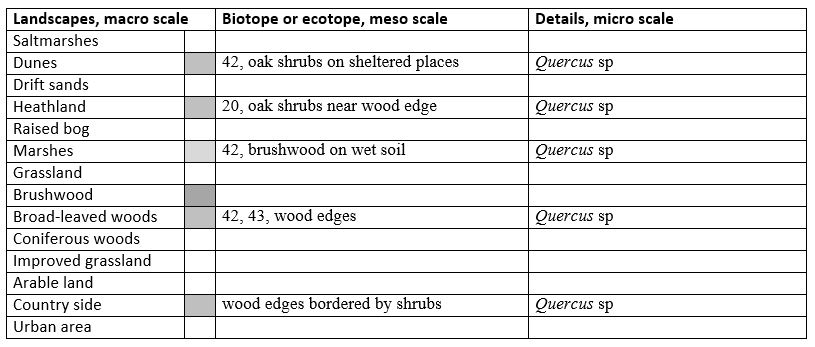
Fig. 44-3. Satyirum ilicis, climate matrix, heat-sums 750 - 2000°d.
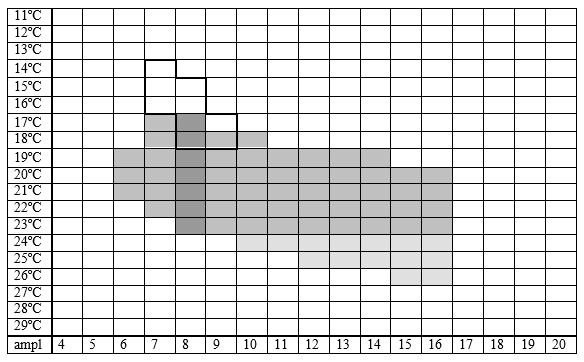
|










